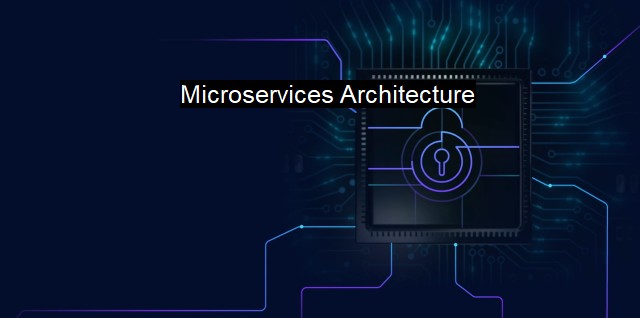What is Microservices Architecture?
Securing the Microservices Architecture: Understanding the Security Risks of Loosely Coupled Systems.
Microservices Architecture refers to an architectural style that structures an application as a collection of services that are loosely coupled, independently deployable, and are centered around specific business capabilities. This popular software development technique has seen widespread adoption over the years due to the numerous advantages it presents such as resilience, ease in scaling, flexibility, and the ability to work with different data models and with multiple programming languages.In a Microservices Architecture, the application is split into a series of smaller services or microservices. Each microservice is focused on a specific function and can be developed, deployed, and scaled independently. Microservices are designed to interact with each other through well-defined APIs and protocols. Microservices encourage the use of simple, lightweight, and loosely coupled communications, usually relying on HTTP/REST with JSON or Protobuf, but often using more advanced Message Bus like RabbitMQ or Kafka.
In the cybersecurity landscape, microservices bring profound implications for application security. One of the greatest advantages of this architectural approach is its inherent scalability and resilience. By its very nature, a microservices architecture is distributed, fault-tolerant, and easy to scale. This means that even in the event of a security failure that affects one part of the system, the integrity of the rest of the system may remain intact. This contributes immensely to the containment of risks.
Despite these advantages, microservices also present new challenges from a cybersecurity standpoint. Each service becomes a potential point of failure or an opportunity for exploits. If a single microservice is compromised, it could potentially impact the entire application depending on the level of access gained in the breach.
Each of these independently operated services require individualized security measures. There is a consistent need to ensure that user data remains secure during transmissions among different microservices, which may happen over unsecure networks. Deals with transaction commitments across different services and data consistency can complicate matters. Proper protocols need to be established for how data is encrypted, shared, and stored between different services.
With the move towards Microservices Architecture, traditional antivirus or monolithic security systems may prove inadequate. The dynamic and distributed nature of microservices requires a fundamental shift in the way we approach system protection. This leads to the approach of using a form of "micro-antivirus," where individual microsecurity protocols monitor and protect each microservice separately from the rest. By enforcing these protocols, businesses can significantly heighten security, ensure data privacy, and meet regulatory compliances.
Micro-segmentation – a security technique that enables fine-grained security policies to be assigned to data center applications – offers an apt solution to securing a Microservices Architecture setup. Also, there are various competent security tools available including container security, network security, and service mesh to secure API communication to orchestrate microservices.
While indeed Microservices Architecture presents a novel approach to security, it is by no means a silver bullet to cybersecurity threats. Developers and security personnel need to be thoroughly versed in the philosophy and practice of a microservices setup to accurately highlight, manage and mitigate any potential security risks.
Microservices Architecture while aiding resilience provides new opportunities and challenges for cybersecurity. Careful, planned, and well-inform strategies of implementations with mutable security measures are essential in ensuring that the architecture serves as an advantage rather than a vulnerability. Through complementary cybersecurity measures such as tailored micro-antivirus or broader tools like micro-segmentation and container security, Microservices Architecture can potentially revolutionize the way we design, implement, and secure our software.

Microservices Architecture FAQs
What is microservices architecture?
Microservices architecture is a method of software development that structures applications as a collection of small, independent, and self-contained services that can be easily deployed and scaled independently of one another.How does microservices architecture benefit cybersecurity and antivirus?
Microservices architecture offers a more secure computing environment by reducing the attack surface area. Each microservice is independently deployed and managed, and only communicates with other services through APIs, which means that a vulnerability in one service will not compromise the entire system. Furthermore, each microservice can be easily updated and patched as needed, making it up-to-date and more resistant to attacks.What are some challenges of implementing microservices architecture in cybersecurity and antivirus?
One of the main challenges in implementing microservices architecture is the potential for increased complexity. With a large number of services available, it can be difficult to establish trust between them, and the management of multiple services can be daunting. Additionally, the use of APIs can create potential vulnerabilities if they are not properly secured, making it essential to have robust security measures in place to protect against attacks.What are some recommended security measures for microservices architecture?
To secure microservices architecture, organizations should implement a range of security measures including encryption, multi-factor authentication, and access controls. Additionally, automated tools can be used to scan code and detect vulnerabilities, as well as to monitor for suspicious activity. It's also important to establish a robust incident response plan to quickly respond to and contain potential security incidents.| | A | | | B | | | C | | | D | | | E | | | F | | | G | | | H | | | I | | | J | | | K | | | L | | | M | |
| | N | | | O | | | P | | | Q | | | R | | | S | | | T | | | U | | | V | | | W | | | X | | | Y | | | Z | |
| | 1 | | | 2 | | | 3 | | | 4 | | | 7 | | | 8 | | |||||||